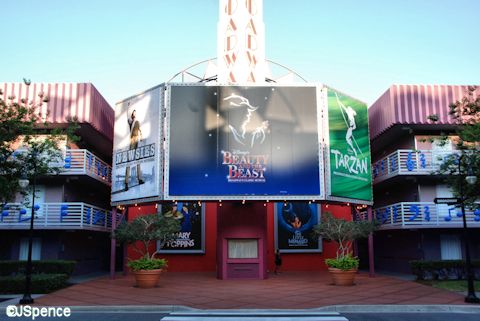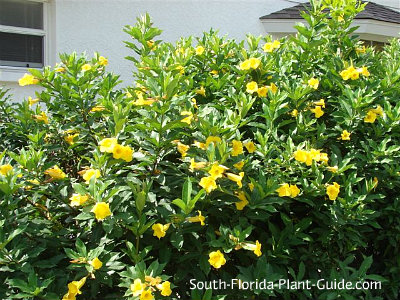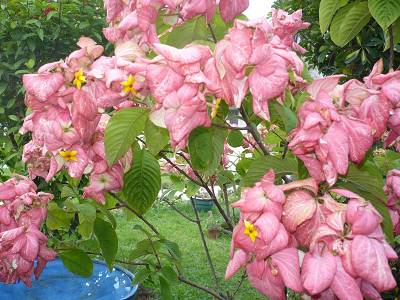Monday started off by walking the gardens and fairways courses. I found a total of 36 balls today which is the most that an intern has found in one day according to the gardener Lance. Then, I was shown my new area as I will be rotating to the resorts (All-Star and Coronado) as of tomorrow. After break I had the opportunity to try out the auger and drill some holes which is a method used to speed up the planting process. Then, we spaced out the shrubs in the yard in order to prevent the plants from becoming leggy. To end the day, I weeded and trimmed back Selloum
which was touching the ground.


Tuesday was my first day at All-Star Resorts. Three resorts make up All-Star they are All-Star Sports, All-Star Music, and All-Star Movies. Within each resort there are different themes by building, All-Star Sports for example has Touchdown, Surf's Up, Home-Run, and Hoops to represent different sports themes. All-Star Resorts is the third largest resort in the nation with 6,500 rooms. I started my day by going with Cathy and watering the interiors inside the lobby's of the three resorts within All-Star. These plants are what guests will see when waiting to check-in, check-out, or ask any questions that they might have therefore we want to create a good atmosphere with healthy looking plants. While watering the interiors, Jim the manager noticed that the pots outside of the buildings need to be changed out which we will be doing next week when the new plants come in. Then, we went over to Rafiki's Planet Watch located within Animal Kingdom and watered the interiors while removing any bad looking leaves. While working on the interiors at Rafiki's planet watch, one of the irrigation people came to fix the irrigation so we had to remove the plants in the area. Unfortunately, he thinks the line might be broke in another spot but could not figure out where. A lot of soil was lost so we were unable to plant new plants in the area so we ended up leaving them in the pots and decided to come back another day as we weren't sure when the area opens. After that, we drove around with a hose on the Toro to where new plants had recently been planted and watered the areas that could not be reached with the water truck. During watering there was a lost child that another family found wandering around. They called security who came to be with the child and a few minutes later the family came and were reunited with their child. I was happy to see how quickly the staff responded and that the child was reunited with his family quickly. We then took the water truck out and watered the areas it could reach. After that, we went to an area and trimmed back
Loropetalum. After lunch we drove around through the different resorts seeing if anything needed attention and took a look at some pots outside of Broadway which is an area in movies. These pots are to be replanted but they wanted some ideas as to what tree to use. The current idea is Crape Myrtle or Italian Cypress. An image of the pots can be seen to the right. As you can see the pots are rather large so the plants need to fill the pots, but they also need to be short so that they don't block the marquee.
Wednesday morning started with Cathy driving the water truck while I helped water the outdoor pots by the entrances to each of the three resorts along with watering any dry areas in the outside beds. Then, we drove around for awhile in the Toro looking for anything that needed to be picked up. Then, we went over to Rafiki's planet watch with some soil and planted the plants which we had laid on top of the soil yesterday and watered them in. After that, we went over by the surf's up pool and did some pruning. While Cathy cut back Selloum, I cut back
Allamanda bush to about waist height. In cutting back the
Allamanda it was discovered that it had mealybugs which we mentioned to the pest management person who will spray them. We had to make a few trips to the dump with debris. Then, we drove around for awhile longer looking at different areas. Before lunch, Cathy went to go look something up on the computer so I went with her and took a few minutes to work on my project as she did not have anything for me to do. After lunch, we drove around looking for an area that Javier the pest management person said was full of weeds however we did not find any in this area and are guessing that the high school weed crew pulled them out. Then, we drove around and removed some junipers in the parking lot beds which had died. We filled the holes with surrounding soil.

Thursday morning Karina and I watered interiors by the check-in areas within All-Star. Then we explored All-Star by driving around. After that, we cut back saw palmetto. Then we dug out and replaced two
Viburnum suspenpensum. After that Chic showed us how to put in St. Augustine sod.
 |
| Tower |
Class today started early as we went on a field trip to Bok Tower Gardens so we left work early. Bok tower gardens was started by Edward Bok and opened in 1929. 30,000 annuals are planted here every year along with a number of endangered plants. We were given a tour by John Arnett who used to work for Disney. He told us that majority of their visitors come in the winter which is the opposite of what I'm used to being from the North gardens are visited primarily in the summer. Upon coming into the garden there were a bunch of orange groves.

Unfortunately a bacterial disease is spreading rapidly through the groves and unless a resistant rootstock is discovered it is likely that all citrus in Florida will be affected in the next 10 years. During the tour we also talked about ridge which is a native area in Florida that is now endangered due to the demand for building. To the left is the bells made up of 85% copper and 15% tin with the largest one weighing 11.7 ton.
While on the trip, we had the opportunity to go into the tower and see the bells which few people get to do (employees do after working at least 90 days, members who donate $1200, and VIPs). While in the tower we learned a lot about the history and maintenance. We also learned more about the history of the garden and how it has been affected by storms like hurricane Charlie. To the right is a picture of Victoria water lilies in the moat surrounding the tower.
To the left is an image of air plants that were hung on a string and could be found near the cafe and gift shop.
The image to the right is from the highest point in Florida known as Iron mountain which is 290ft. above sea level. I really enjoyed the trip to Bok tower gardens.


Friday morning Karina and I went with Dan and watered pots outside the Animal Kingdom lodge. We used a sprayer that would normally be used for fertilizing or spraying pesticides but was used for just water in this case so that it could also be used to wash off the plants and because there is nowhere to hook up a hose and a watering can would be inefficient. Then, we went and watered Rafiki's planet watch and replaced some plants which had been damaged by visitors. After that we cut down some Hawaiian Ti which was getting to tall as it was blocking the window. We then dug small holes around them and stuck in the cuttings as we are going to try and get them to root. A picture of Hawaiian Ti is to the right. After that, we trimmed back some hanging baskets in an attempt to better expose the succulents at the top and those stuck in the sides of the baskets. The hanging baskets are pictured above.
Plant of the Week:

The plant of the week is
Allamanda schottii Allamanda bush. Flowers are golden trumpet-shaped borne in clusters and appear for most of the year. These plants tend to become bare at the base as they become more mature. There is a dwarf variety available if the bush variety is too large for the desired area. They are evergreen and moderately salt-tolerant.
Allamanda prefers full to partial sun and does best in zone 10. They can be trimmed at 3 feet while young and then 4 or 5 feet once mature. Trimming should be done in late March or early April. Watering should occur on a regular basis but allowing it to dry out between watering. Fertilizing should occur 3 times a year (spring, summer, and autumn). Plants should be spaced every 3 feet. Information from the South Florida Plant Guide http://www.south-florida-plant-guide.com/bush-allamanda.html




 The plant of the week is Tecomaria capensis also known as Cape Honeysuckle. It is found in the Bignoniaceae family. Cape honeysuckle is a sprawling, sometimes vine-like shrub with evergreen, opposite, pinnately compound leaves about 6" long. There are 5-7 diamond-shaped leaflets that are toothed and about 2" long. Cape honeysuckle produces clusters of red-orange to scarlet tubular flowers in the fall and winter, each about 2" long. As a shrub it can be maintained to 10' or more in height and half as wide, but if left alone without pruning it can cover 25' or more. Cape honeysuckle grows rapidly. Specific cultivars include 'Apricot' which is smaller and more compact with orange flowers and 'Aurea' which has yellow flowers. Cape honeysuckle originates from the Cape of Good Hope region of South Africa, where there are more endemic plant species (species that occur nowhere else) than any other area in the world. It has escaped from cultivation and become established in disturbed areas in Hawaii and Central Florida. Cape honeysuckle does best in full sun but tolerates light shade. It needs good drainage and does best with regular water, but is moderately drought tolerant once established. Tecomaria is for USDA hardiness zones 9-11 and is hardy to at least 26ºF. Propagation involves softwood cuttings at any time of the year and by seeds. It will take root anywhere branches touch the ground. Common uses of cape honeysuckle include as a climbing vine or barrier hedge/screen, trained as a specimen shrub or used as a ground cover on steep slopes or rocky banks. It can also be used as a cascading plant over walls and planters or trained as a garden arch. Tecomaria is salt tolerant and accepts acidic to alkaline soils. Cape honeysuckle is known to attract hummingbirds and orioles and flowers most of the winter. Information from: http://www.floridata.com/ref/t/teco_cap.cfm
The plant of the week is Tecomaria capensis also known as Cape Honeysuckle. It is found in the Bignoniaceae family. Cape honeysuckle is a sprawling, sometimes vine-like shrub with evergreen, opposite, pinnately compound leaves about 6" long. There are 5-7 diamond-shaped leaflets that are toothed and about 2" long. Cape honeysuckle produces clusters of red-orange to scarlet tubular flowers in the fall and winter, each about 2" long. As a shrub it can be maintained to 10' or more in height and half as wide, but if left alone without pruning it can cover 25' or more. Cape honeysuckle grows rapidly. Specific cultivars include 'Apricot' which is smaller and more compact with orange flowers and 'Aurea' which has yellow flowers. Cape honeysuckle originates from the Cape of Good Hope region of South Africa, where there are more endemic plant species (species that occur nowhere else) than any other area in the world. It has escaped from cultivation and become established in disturbed areas in Hawaii and Central Florida. Cape honeysuckle does best in full sun but tolerates light shade. It needs good drainage and does best with regular water, but is moderately drought tolerant once established. Tecomaria is for USDA hardiness zones 9-11 and is hardy to at least 26ºF. Propagation involves softwood cuttings at any time of the year and by seeds. It will take root anywhere branches touch the ground. Common uses of cape honeysuckle include as a climbing vine or barrier hedge/screen, trained as a specimen shrub or used as a ground cover on steep slopes or rocky banks. It can also be used as a cascading plant over walls and planters or trained as a garden arch. Tecomaria is salt tolerant and accepts acidic to alkaline soils. Cape honeysuckle is known to attract hummingbirds and orioles and flowers most of the winter. Information from: http://www.floridata.com/ref/t/teco_cap.cfm 

















